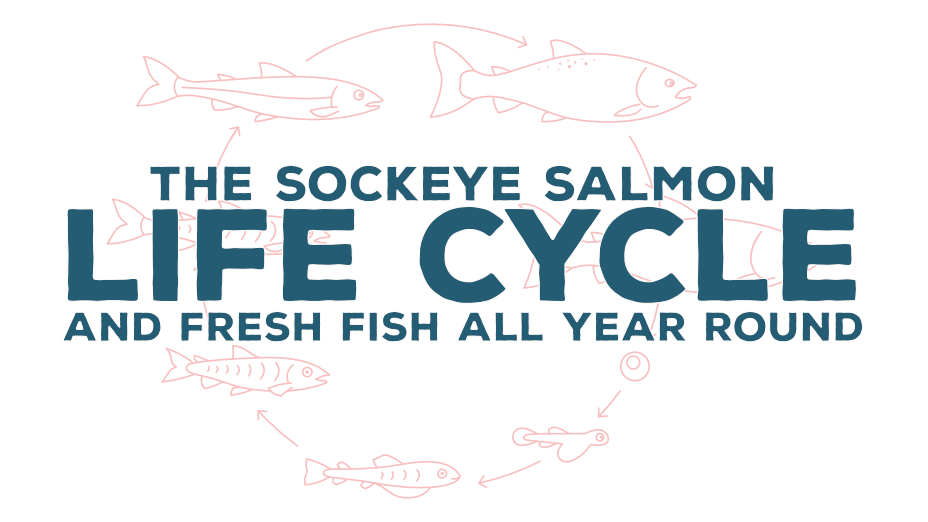At Wild for Salmon, every story begins in Bristol Bay, Alaska where the air is crisp, the rivers run red with life, and the crew of the F/V Ava Jane chases the wild sockeye salmon each summer.
We built our business on this fish: wild, nutrient-rich, and sustainably caught. And though the season itself lasts only a few fleeting weeks, the work and the story continues all year long.
Here’s how the sockeye salmon life cycle intertwines with our own, and how we make it possible for you to enjoy the taste of fresh, wild Alaska salmon year-round even from our home base in Pennsylvania. 
Our Sockeye Salmon Season: When and How It Happens
Each June, Steve and the crew of the Ava Jane head north to Bristol Bay, Alaska home to the world’s largest sockeye salmon run. For a few short weeks, millions of fish return from the open Pacific to the freshwater rivers where they were born. The whole bay comes alive: planes buzz in the sky, nets are mended on shore, and fishermen brace for the season’s electric energy.
From mid-June through early August, we fish the tides catching only a small fraction of the salmon that surge through the bay. Every catch is handled with care, then delivered directly to our trusted partners at Leader Creek Fisheries, where it’s filleted and flash-frozen within hours.
The result? Salmon that captures the vibrancy of Alaska’s summer preserved at its peak for you to enjoy, any time of year.
The Sockeye Salmon Life Cycle 
Sockeye salmon live one of nature’s most poetic cycles a journey of transformation, endurance, and return.
Like all Pacific salmon, they are anadromous born in freshwater, living most of their lives in the ocean, then returning to the exact riverbed where they began to spawn and complete the cycle.
Here’s how their story unfolds:
-
Eggs: Laid in gravel nests called redds during late summer and fall.
-
Alevins: Newly hatched fish, still attached to their yolk sacs, nestled safely in the riverbed.
-
Fry: Young salmon that emerge into the open water, spending one to two years in the freshwater lakes and streams near Bristol Bay.
-
Smolts: Maturing fish that adapt to saltwater and begin their migration to the open ocean.
-
Adults: After two to three years at sea, they return to their natal rivers to spawn completing a life cycle that has unfolded for millennia.
Every summer, when the salmon return to Bristol Bay, they bring with them the strength of the ocean and the promise of renewal.
The Wild for Salmon Cycle
Our cycle mirrors theirs driven by seasons, sustained by care, and guided by respect for the resource.
Summer: The Harvest
The sockeye return, and the crew of the Ava Jane heads out. For six weeks, we harvest wild salmon as they flood the bay, then deliver them to Leader Creek Fisheries, where state-of-the-art spiral freezers lock in freshness faster than any home freezer could. Each fillet is vacuum-sealed and handled with precision.
Fall: The Journey Home
Once frozen, the salmon travels by barge from Bristol Bay to cold storage in Seattle — then by truck across the country to our Wild for Salmon headquarters in Bloomsburg, Pennsylvania. Here, our team transforms the catch into value-added products like salmon dip and begins shipping orders nationwide.
What started at local farmers markets has grown into a full storefront and fulfillment center, connecting families everywhere to wild Alaska’s best.
Winter: The Work Behind the Scenes 
While the bay rests under ice, our work continues. Fishermen repair boats and nets, and our team ships orders to homes across the U.S., making wild-caught seafood a staple of weeknight dinners. Even as sockeye sleep, the sea stays alive — our partners harvesting Pacific cod and other coldwater species through the winter months.
Spring: Preparing for Return
As the ice melts, preparations begin anew. Flights are booked, crews are hired, and the excitement builds. Back in Pennsylvania, customers begin restocking their freezers and dreaming of summer grilling.
“Fresh” Salmon, Year-Round
A common question we hear: If salmon is caught in summer, how can it be fresh all year long?
The answer lies in technology and care. The flash-freezing process at Leader Creek freezes the fish at temperatures far colder than standard freezers preserving texture, flavor, and nutrients for up to two years.
What many grocery stores label as “fresh” salmon has actually been previously frozen and thawed. At Wild for Salmon, we keep our fish frozen until it reaches you — so when you thaw it at home, you’re experiencing true freshness, as if it came off the boat yesterday.
As we like to say:
Arrives frozen, tastes fresh as can be.
A Promise from Bristol Bay
Because the sockeye salmon run lasts only a few short weeks, the only truly “never-frozen” salmon is the one you catch yourself on an Alaskan riverbank in July. For everyone else, there’s Wild for Salmon — your year-round connection to the wild.
Every fillet we share is a reflection of the life cycle that sustains us: salmon returning home, fishermen honoring tradition, and customers who care deeply about what’s on their table.
Until you can cast your own line in Bristol Bay, we’ll bring the taste of that wild summer to you — frozen perfectly, with care and intention.




